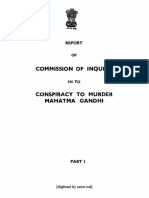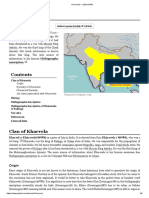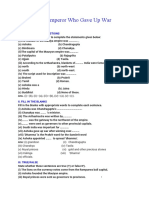Boyar History
Boyar History
Uploaded by
Santhosh KumarCopyright:
Available Formats
Boyar History
Boyar History
Uploaded by
Santhosh KumarOriginal Description:
Copyright
Available Formats
Share this document
Did you find this document useful?
Is this content inappropriate?
Copyright:
Available Formats
Boyar History
Boyar History
Uploaded by
Santhosh KumarCopyright:
Available Formats
A Boyar also spelled boya (Hunter/Warrior) is the name of a caste.
A
leader of a group or Head of Territory. Boya is called as Naidu in
Andhrapradesh is similar to kapu (caste).Boya is called as Boyar in
TamilNadu they constitute the non-Orthodox Kshastriya or warrior class
of India. They are all believed to have originated from an ancient
people called kirata. Boyars are non-orthodox kshatriya or vratya
according to manuscript.
Near about 18 million of Boyar community people are living throughout
all over in India.3 million peoples are living in TamilNadu.
Boyars bounded to mountainous regions in south-eastern peninsula
near the Orissa-Andhra region. The original population of Boyas was
mixed with various linguistic groups later, such as the Telugu speaking
community, and spread to all southern states. These Boya warriors
served at the military regiments and chiefs between 10th century to
15th century in Chalukya, Chola, Vijayanagar, and Hoysala empires.
The eastern Chalukyan empire’s court was essentially a Republic of
Badami, and the administrative subdivisions were known as 'Boya-
Kottams'. Boya-Kottams existed across the southern states right from
5th century, according to Kakatiya inscriptions. Boya-Kottams held
assignments of land or revenue in different villages. Chola-Chalukyas
used the titles 'Udayar' or 'Odeyar' for chieftains at certain periods of
time, which included Boya Chieftains.
The Musunuri Nayaks were Boya and Kamma warrior chieftains in the
Kakatiya army who regained Andhra in 1326 from the Delhi Sultanate
in the aftermath of the Kakatiya defeat. King Pratapa Rudra’s Kakatiya
kingdom was aptly served by seventy five chieftains called Nayaks. The
Nayaks, who belonged to various agrarian castes such as Boyar,
Velama, Kamma, Reddy, Telaga, and Balija, were divided by mutual
jealousy and rivalry, but were valiant cousins.
The Chitradurga Palaegar (Polygar) family was of the Beda or Boya,
caste and belonged to one of the hunting hill tribes. According to one
tradition, the Boya families emigrated from Jadikal-durga, in the
neighbourhood of Tirupati, and settled at Nirutadi, near Bramhasagara,
at about 1475 AD. They are said to have belonged to the Kamageti
family. The son and the grandson of one of these was named Hire
Hanummappa Nayaka and Timmanna Nayaka, respectively. There were
many battles in the reign of this Nayaka between Chitradurga,
Harapanahalli, Rayadurga, and Bijapur, in all of which the Nayaka had
splendid success. ([9])Rayadurg and Kalyandurg are two important
forts which were ruled by Boya Palaegars. The name Kalyandurg came
from Boya Kalyanappa, who was a Palaegar in the 16th century.
Rayadurg was originally a stronghold of Boya Palaegar, which was very
turbulent during the Vijayanagar rule. Kalyandurg was under the rule of
Sri Krishnadevaraya and was a part of Vijayanagar Empire.([10]) Sri
Krishnadevaraya was ruling over the Vijayanagar empire from 1509 AD
to 1529 AD. In about 1562, there were very well-known Nayakas in the
Vijayanagar army were 'Boya Ramappa' and 'Tipparaju', the Boya chief
of Pulivendakonda and the palaegars of Kotakonda-Kappatralla.
In about 1517, Chitradurga Fort was given by Vijayanagar ruler to a
Boya chief. It became a tributary to Bijapur after fall of Vijayanagar.
There were portraits of ‘A Boya of Rank’, a member of the royal caste
(related to royal family) of Chitradurga Nayaks who was documented by
Colin Mackenzie.([11])
These princes and Boya chiefs were invariably valorous in battle,
merciful and generous to their enemies, wise and discreet in their
administration, far-sighted in their policy, thoroughly religious and
orthodox in their belief and liberal to a fault. These powerful chieftains
had some French engineers in their service and built very strong
fortresses and other public utilities as standing monuments of their
glory.
Rayadurg and Kalyandurg are two important forts which were ruled by
Boya Palaegars. The name Kalyandurg came from Boya Kalyanappa,
who was a Palaegar in the 16th century. Rayadurg was originally a
stronghold of Boya Palaegar.
In 1786, Harapanahalli, a town in the Bellary District, was in possession
of a powerful Palaegar of the Boya caste. One of the descendants
married a daughter of Palaegar of Chitradurga. The Palaegars at
different times paid tribute to the Nizam, Morari Rao of Gooty and the
Peshwa. The fort was deserted and now in ruins.
Later, in 17th century, the Boyars distinguished themselves as smiths,
sculptors, nobles, leaders, priests, landlords, temple sculptors, arm
traders, and seafarers.
References
ORISSA-ANDREW STERLING-PRAFULLA-P.14,60,94,113
The character of Majura Empire-chronology and limits by
B.N.Mukharji,Pritonia publishers,Kalcutta 700009.p46.63a,33.
Recent discoveries of Jaina Cave inscriptions in Tamilnadu by
I.Mahadevan.Rishaba-Sandarbha-Delhi 1994.P.P.123-7
Puratattua.vol.xxv.pp 2728.
Tribal cultural heritage and cult by DAS KORNEL.p.16. study
center,Hyderabad.
Guptha Empire-A-287 by India History for IAS.IPS. study
centre,Hyderabad.
ORISSA by Dr.Shree Ram Chandra Dash Con Historical Background
ATLAS
Paradigms in Indian History. Osmania University,Hyderabad-500
007(2003).Relations of Andhra Desa with Tamil Region during the
period of nayakas by prof:K.Kusuma Bai(p.339,340)
Asoka by vineent.A.smith.OXFORD,at the clarendan press.MCM XX
p.161,210.
The criminal classes in India –Bombay presidency by M.Kennedy-
MITTAL Publications,Delhi(p.166 to 172).
HINDU TRIBES and CASTES by Rev.M.A.SHERRING.M.A.LLB Fellow of
the Calcutta university,cosmo publications,Delhi(1974)(vol2.p.345).
Tamilaga Varalarum Panbadumby prof:M.PRAKASH Govt.Arts
College,ARIYALUR publisher:porechudar padippagam
No2,kadalangudy,Mayuram Tk,Tanjavur(part1 &2-p.113,321).
ARULMIGU Sangameswarar Thirukoil,Kottai,Coimbatore Thalavaralaru.
The GREAT CHOLA TEMPLES by Archaeological Survey of india.
Konark BLACK PAGODA by KARUNA SAGAR BEHERA by Ministry of
Information & Broad Casting,Publication Division,Government of
India,Basant Nagar,Chennai(p.7)
Indian caste by John Wilson
You might also like
- Indian Medical Devices Sector ReportDocument33 pagesIndian Medical Devices Sector ReportPradip SinghiNo ratings yet
- Article - Historical Background of The KalachurisDocument4 pagesArticle - Historical Background of The KalachurisMonal BhoyarNo ratings yet
- History Class7 TN BoardDocument74 pagesHistory Class7 TN BoardSalman SabriNo ratings yet
- Palegar PalayakararDocument40 pagesPalegar Palayakararvijay_music88100% (5)
- Gupta Age Post Gupta Age Harsha Age Early Medieval Kingdoms 1 97Document12 pagesGupta Age Post Gupta Age Harsha Age Early Medieval Kingdoms 1 97SeemaNo ratings yet
- THANJAVURDocument6 pagesTHANJAVURGeetesh SaravananNo ratings yet
- Pallavas AdministrationDocument14 pagesPallavas AdministrationSrushti GhodeNo ratings yet
- Ancient Literature - 25407301 - 2024 - 07 - 13 - 23 - 27Document8 pagesAncient Literature - 25407301 - 2024 - 07 - 13 - 23 - 27surya01418No ratings yet
- Regional States During Gupta EraDocument2 pagesRegional States During Gupta EraLalit SinghNo ratings yet
- Ancient & Medieval History Terminologies RRP 2022.Document29 pagesAncient & Medieval History Terminologies RRP 2022.shivankur sharmaNo ratings yet
- S.No Court Poet in The Court of Well-Known WorksDocument4 pagesS.No Court Poet in The Court of Well-Known WorksCheruku ManoharNo ratings yet
- Indian River SystemDocument14 pagesIndian River Systemroja sapavatNo ratings yet
- Pallava DynastyDocument51 pagesPallava DynastyDharani 12biomathsNo ratings yet
- DownloadDocument10 pagesDownloadyogeshwarattriNo ratings yet
- History of Mysore (1399-1799 AD)Document743 pagesHistory of Mysore (1399-1799 AD)Satish S NayakNo ratings yet
- Criminal Tribes Act - Chapter V PDFDocument49 pagesCriminal Tribes Act - Chapter V PDFPavithran Velu RavivarmanNo ratings yet
- Katyuri KingsDocument3 pagesKatyuri KingsPushpa B SridharanNo ratings yet
- Mains Paper Module Karnataka History Set 1Document35 pagesMains Paper Module Karnataka History Set 1anon_517945911No ratings yet
- Kharabela & Gupta DynastyDocument44 pagesKharabela & Gupta Dynasty09whitedevil90No ratings yet
- The Pala EmpireDocument3 pagesThe Pala Empiresakibul HasanNo ratings yet
- Pre MauryanDocument16 pagesPre MauryanChandan Kumar RoyNo ratings yet
- KSP - Gov.in Karnataka PSI Syllabus PDF - General StudiesDocument2 pagesKSP - Gov.in Karnataka PSI Syllabus PDF - General StudiesChethan KumarNo ratings yet
- List of Water Falls in IndiaDocument12 pagesList of Water Falls in IndiaAnuj SinghNo ratings yet
- Ashoka Edicts & InscriptionsDocument1 pageAshoka Edicts & InscriptionsappuNo ratings yet
- History of RajanieeshDocument212 pagesHistory of Rajanieeshasdf adfcxNo ratings yet
- Modern History RajDocument63 pagesModern History Rajhemant.niotNo ratings yet
- Wildlife Sanctuaries in KarnatakaDocument7 pagesWildlife Sanctuaries in KarnatakaPradeep AryaNo ratings yet
- Of Tribes, Hunters and Barbarians - Forest Dwellers in The Mauryan PeriodDocument20 pagesOf Tribes, Hunters and Barbarians - Forest Dwellers in The Mauryan PeriodZaheen AkhtarNo ratings yet
- History of Ancient India: Avks AcademyDocument21 pagesHistory of Ancient India: Avks AcademysayaliNo ratings yet
- Ancient History Notes PDFDocument8 pagesAncient History Notes PDFaryan singhNo ratings yet
- 1969 Report of Jeevan Lal Kapur Commission of 2 PDFDocument367 pages1969 Report of Jeevan Lal Kapur Commission of 2 PDFAnonymous iMq2HDvVqNo ratings yet
- Chalukya DynastyDocument16 pagesChalukya DynastyArjun Singh RathoreNo ratings yet
- 07 Chapter 1Document34 pages07 Chapter 1SontappagariViswanath100% (1)
- Important Books From Ancient IndiaDocument4 pagesImportant Books From Ancient IndiaJay JonesNo ratings yet
- 09 - Chapter 2 PDFDocument245 pages09 - Chapter 2 PDFVishnuNo ratings yet
- Ancient Indian History - Maurya DynastyDocument4 pagesAncient Indian History - Maurya DynastyEkansh Dwivedi100% (1)
- NcertDocument20 pagesNcertManoj SadanandamNo ratings yet
- Kalabhras Part 2 ExtendedDocument79 pagesKalabhras Part 2 ExtendedRavi SoniNo ratings yet
- Chapter 13 Literature and Culture PDFDocument72 pagesChapter 13 Literature and Culture PDFAbhi100% (1)
- Ancient IndiaDocument13 pagesAncient IndiaMitali VadgamaNo ratings yet
- Kharavela - WikipediaDocument11 pagesKharavela - WikipediaFlorosia StarshineNo ratings yet
- The Madras PresidencyDocument321 pagesThe Madras PresidencySomebodythatyouusedto_know100% (1)
- Medieval History by DNYAN IASDocument35 pagesMedieval History by DNYAN IASvedha's preparationNo ratings yet
- History-Of-Bihar-BPSC-Notes RamzDocument27 pagesHistory-Of-Bihar-BPSC-Notes RamzaafiarahberNo ratings yet
- Kharavela - Jatland WikiDocument8 pagesKharavela - Jatland WikiFlorosia StarshineNo ratings yet
- The Southern Dynasties Study MaterialsDocument9 pagesThe Southern Dynasties Study MaterialsSayak MukherjeeNo ratings yet
- Tamil Nadu 8th Standard HistoryDocument48 pagesTamil Nadu 8th Standard HistoryIndia History Resources100% (1)
- The Odisha Official Language Act and Language Movement in 21st Century AdDocument7 pagesThe Odisha Official Language Act and Language Movement in 21st Century AdEditor IJTSRDNo ratings yet
- Art&Culture Quick Revision NotesDocument41 pagesArt&Culture Quick Revision NotesStudy IQ GuideNo ratings yet
- Western GangasDocument13 pagesWestern GangasVani MadhuKiranNo ratings yet
- 150+ One Liner Festivals in IndiaDocument8 pages150+ One Liner Festivals in IndiaJAIKISHAN GUPTANo ratings yet
- The Kadamba DynastyDocument3 pagesThe Kadamba Dynastyaar_unlimited9351No ratings yet
- Features of Mahakavya in Kalidasa's RaghuvamsaDocument10 pagesFeatures of Mahakavya in Kalidasa's RaghuvamsaDevdut MandalNo ratings yet
- Munda People - A Product of Parashurama's FuryDocument95 pagesMunda People - A Product of Parashurama's FuryJayasree SaranathanNo ratings yet
- Rajasthan G.K. Spring BoardDocument24 pagesRajasthan G.K. Spring BoardAmit HayaranNo ratings yet
- The Tribes and Castes of the Central Provinces of India, Book IIFrom EverandThe Tribes and Castes of the Central Provinces of India, Book IINo ratings yet
- Mahabharat: Tales From The Epic for Children of All AgesFrom EverandMahabharat: Tales From The Epic for Children of All AgesNo ratings yet
- HistoryDocument86 pagesHistoryAmit kumar100% (2)
- Ncert Notes: Medieval History - The North Indian Kingdoms - The RajputsDocument47 pagesNcert Notes: Medieval History - The North Indian Kingdoms - The RajputsMathiraja.TNo ratings yet
- Medival History PDFDocument84 pagesMedival History PDFclinfoxNo ratings yet
- Parishram TemplateDocument1 pageParishram TemplateAbhishek ChandraNo ratings yet
- Chapter2 PDFDocument31 pagesChapter2 PDF321876No ratings yet
- Phoenix MillsDocument156 pagesPhoenix MillsChandan PatekarNo ratings yet
- Rbis Ifsc & MicrDocument425 pagesRbis Ifsc & MicrJayakumar KingNo ratings yet
- 300 Latest Lecturette TopicsDocument10 pages300 Latest Lecturette TopicsAnjali DahiyaNo ratings yet
- Notes On Ashoka The Emperor Who Gave Up WarDocument14 pagesNotes On Ashoka The Emperor Who Gave Up WarRemya ReghuNo ratings yet
- Class VI Select List For Summer Bound JNVs of Pune Region PDFDocument346 pagesClass VI Select List For Summer Bound JNVs of Pune Region PDFYogesh SaindaneNo ratings yet
- 08 54 30amDocument1 page08 54 30amsureshNo ratings yet
- Ancient Literature in IndiaDocument4 pagesAncient Literature in IndiaEric Pajuelas EstabayaNo ratings yet
- Class 9 - SSTDocument51 pagesClass 9 - SSTA AliNo ratings yet
- Introductory Session On Indian Society and CultureDocument30 pagesIntroductory Session On Indian Society and CultureSmriti BajpayeeNo ratings yet
- India's Foreign Policy 60 YrsDocument17 pagesIndia's Foreign Policy 60 YrsAdhar KumarNo ratings yet
- Indian & Global Scenario - RetailingDocument13 pagesIndian & Global Scenario - RetailingHarmeet SinghNo ratings yet
- Class 12 Cbse Sociology Sample Paper Model 2Document10 pagesClass 12 Cbse Sociology Sample Paper Model 2Sunaina RawatNo ratings yet
- TAMIL NADU Poorvika Mobiles StoreDocument119 pagesTAMIL NADU Poorvika Mobiles StoreVijay RaghavanNo ratings yet
- 4 Revised - AIS - Rule - Vol - II - IAS - Rule - 01 - 4 PDFDocument42 pages4 Revised - AIS - Rule - Vol - II - IAS - Rule - 01 - 4 PDFUnmesh BagweNo ratings yet
- Sisaat Sae SURI Feries: Indian Oil Corporation Limited IngianoilDocument2 pagesSisaat Sae SURI Feries: Indian Oil Corporation Limited IngianoilPankaj MauryaNo ratings yet
- Kulwinder Kaur: Kaurk@jmi - Ac.inDocument12 pagesKulwinder Kaur: Kaurk@jmi - Ac.inPsycho ScorpionNo ratings yet
- TSPSC GR II III Test Series Genius Online (RD)Document24 pagesTSPSC GR II III Test Series Genius Online (RD)Shree SreeNo ratings yet
- Assignment: Humaira Fabiha : 201932026Document15 pagesAssignment: Humaira Fabiha : 201932026Shubho Dev nathNo ratings yet
- Khurda Bachelor CollegesDocument2 pagesKhurda Bachelor CollegesSatyabrataNayakNo ratings yet
- Essay On Mahatma GandhiDocument9 pagesEssay On Mahatma GandhichethanNo ratings yet
- Indian Independence Act 1947Document6 pagesIndian Independence Act 1947अनुराग सिंहNo ratings yet
- India Pakistan RelationsDocument22 pagesIndia Pakistan Relationsnoman90No ratings yet
- Om BirlaDocument5 pagesOm Birlanavinvsuthar3No ratings yet
- The Position of Urbanization in IndiaDocument4 pagesThe Position of Urbanization in IndiaSaurabhNo ratings yet
- Punjab National Bank of IndiaDocument4 pagesPunjab National Bank of IndiaBalendu SinghNo ratings yet
- Syllabus For The Ma HistoryDocument10 pagesSyllabus For The Ma Historynandi_scrNo ratings yet
- TruptiDocument5 pagesTruptiSaurabh ShubhamNo ratings yet

























































































